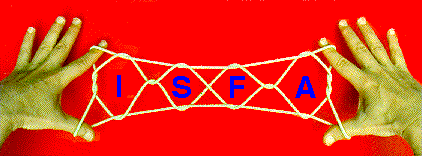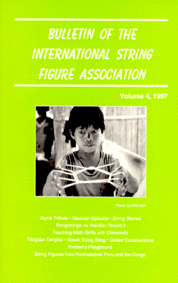Volume 4 (1997): 240 pages - Table des Matières
Edité par - Mark A. Sherman, Pasadena, California
Rédacteurs Associés - Joseph D'Antoni, Queens, New York; Myriam Namolaru, Haifa, Israel;
Belinda Holbrook, Davenport, Iowa; Stephan Claassen, Best, Netherlands.
Comité de Rédaction - Hiroshi Noguchi, Tokyo, Japan; Philip Noble, Inverness, Ecosse
Le Bulletin de l'Association Internationale du Jeu de Ficelle (BISFA) est une publication savante
présentant des documents originaux qui fait progresser notre compréhension et renforce
notre plaisir des jeux de ficelle. BISFA est publié annuellement, en septembre, par ISFA Press
(Pasadena, Californie). BISFA remplace le Bulletin de l'Association des Jeux de Ficelle,
(Toky Nippon Ayatori Kyokai), qui a été publiée en 19 volumes (1978-1993).
Les traductions proposées ne comprennent pas les illustrations et photos du texte original.
J'ai traduit ces textes pour vous donner un aperçu de la qualité et de la richesse de
ces publications.
Tribute
- Caroline Furness Jayne (1873-1909) par Michael D. Meredith, Amarillo, Texas, (pages 1-7) - Une biographie de l'auteur du premier livres sur les jeux de ficelle, publié en 1906.
Commentary
- Episode Nauruen : L'Histoire de Mes Aventures passées à recueillir des jeux de ficelle sur l'Ile de Nauru , par Honor C. Maude, Canberra, Australie, (pages 8-11) - La monographie de Mme. Maude de 1971 sur les jeux de ficelle de l'Ile de Nauru est considérée comme un classique. Ici, elle relate les circonstances qui lui ont permise de recueillir les figures, pendant les années 1937-38.
- " On va à la pêche" -- Une histoire ficelée , par Brian Cox, Winnipeg, Manitoba, Canada, (pages 12-16) - Brian Cox emploie la magie, l'origami et les jeux de ficelle pour divertir les enfants dans tout le Canada. Son histoire la plus populaire est présentée ici, accompagnée par des photos qui illustre les figures qu'il emploie.
- Histoires Ficelées -- Mon Histoire : Un récit autobiographique des jeux de ficelle dans ma vie et des histoires qui les accompagnent , par Edd Sterchi (Wakahana), Flora, Illinois, (pages 17-29) - Enfant, Edd Sterchi a appris les jeux de ficelle de sa grand-mère, une Indienne Choctaw. Plus tard il en a inventé quelques uns. Ici il explique comment les réaliser, et montre comment ils peuvent être utilisés dans une histoire.
Research Reports
- Rongorongo versus Kai-kai: A second look at themes linking Easter Island’s mysterious script with its string figure repertoire, by Sergei V. Rjabchikov, Krasnodar, Russia, (pages 30-55) - In my previous paper I examined parallels between themes encoded within Easter Island’s rongorongo script and the ancient chants associated with six of the island’s traditional string figures. I also described how several of these string figures physically resemble glyphs inscribed on the rongorongo boards. In this paper, I present twenty-five additional examples. I also present similarities found upon examination of the Hawaiian, Marquesan, Tahitian, and Maori repertoires -- similarities which suggest that at one time, the rongorongo writing system may have been known throughout Polynesia.
- Usage de jeux de Ficelle pour l'Enseignement de l'Adresse Mathématique -- Partie 1: Le Système Diamant, par James R. Murphy, Whitestone, New York; avant-propos par Gelvin Stevenson, Bronx, New York, (pages 56-74). - La capacité à penser en termes abstraits est unique à l'espèce humaine. Les math sont un langage abstrait, le plus puissant et manipulatoire, disponible pour nous. Malheureusement les étudiants de nos jours sont souvent “timides en math” et par conséquent, n'acquièrent jamais les talents mentaux nécessaires à une pensée haute. Les jeux de ficelle sont un plaisir visuel et un moyen tactile merveilleux pour apprendre à apprécier un phénomène conséquent complexe. Cet article présente le premier des quatre “systèmes” du jeu de ficelle développés par l'auteur pour enseigner aux étudiants à penser systématiquement.
- Tikopia’s Web-Weaving Techniques, by Masahiko Eguchi (1918-1985), Kazuo Kamiya, Saitama, Japan, and Tetsuo Sato, Kumamoto, Japan, (pages 75-89) - Tikopian web-weaving techniques can be used to create many interesting string patterns. When these techniques are iterated and combined with other movements, any number of string figures are possible.
- Plinthios Brokhos: The earliest account of a string figure construction, by Joseph D'Antoni, Queens, New York, (pages 90-94) - Modern written records of string figure constructions are scarcely more than a century old, but 1,800 years ago, a Greek physician named Heraklas described a knot construction which may also be the earliest description of how to make a string figure.
- Instructions for the Observation and Recording of String Figures: An unpublished German manuscript by Erich M. von Hornbostel, by Udo Engelhardt, Berlin, Germany, (pages 95-119) - In this article I present an English translation of an unpublished manuscript written by E. M. von Hornbostel. In it, the author presents a highly original system and set of symbols for recording string figure construction methods. He also offers advice on how to document newly discovered string figures, and how to evaluate an informant’s skill. This translation opens with a short biography of Erich von Hornbostel and concludes with several letters written by ethnologists who reviewed the manuscript shortly after it was written.
- String Figures from Northeastern Peru, by Will Wirt, Port Angeles, Washington, (pages 120-134) - String figures remain a popular form of recreation in the Amazon River region of northeastern Peru. This paper describes a series of figures collected during a trip along a 110 mile stretch of the Amazon River and some of its tributaries.
- String Figures from the Congo, by Carey C.K. Smith, Stratford, New Zealand (pages 135-184) - This article presents sixty-seven string figures gathered at Upoto in the former Belgian Congo by Mrs. Ethel M. Smith during the years 1910-14. Among her informants were members of the Lingombe, Lifoto, Ngombe, Ngwenzali, and Ngwengali tribes. Unlike F. Starr’s Congo collection published in 1909, the Smith collection includes methods of construction for each figure. In an appendix to this article, the author presents methods for making thirty-nine of the sixty-two figures described by Starr.
- Nouveaux Jeux de Ficelle pour le Jeu de l'Artiste (plus divers motifs et notes, par Martin Probert, Hartley, Plymouth, England, (pages 185-202) - Parmi les population indigènes du monde, les jeux de ficelle sont souvent employés pour raconter une histoire ou pour divertir une audience. Etant donné que les noms donnés appartiennent souvent à une culture spécifique, beaucoup de figures perdent leur valeur de divertissement lorsqu'elles sont présentées à un public non indigène. Dans cet article, l'auteur offre une collection de figures dont les noms sont sûrs d'amuser un public de citadins modernes.
Book and Video Reviews - by Joseph D'Antoni and Mark Sherman (pages 203-208)
- Cat's Cradles, Owl's Eyes -- A Book of String Games; Many Stars and More String Games; Super String Games, by Camilla Gryski.
- Fumble Fingers, Moose Enterprise.
- String Games, by Michelle Foerder.
- String Magic from Around the World (Video), by David Titus.
- Fool of the Kingdom: How to be an Effective Clown Minister, by Philip Noble.
- History and Science of Knots, edited by John C. Turner and Pieter van de Griend.
- String Figures of the Marquesas and Society Islands, by Willodean C. Handy.
- String Figures from Fiji and Western Polynesia, by James Hornell.
- String Figures from Hawaii, by Lyle A. Dickey.
Letters to the Editor (pages 209-223)
- String in the Stone Age - Yukio Shishido, Kyoto, Japan. A letter drawing attention to Saharan rock art images that may portray string figures being made.
- Chacun Son Got - Deux - Sam Cannarozzi Yada, Chasselay, France. The author defends his belief that the scientific study of string figures robs them of their spirit.
- Japanese and Polynesian String Figures: A Common Origin? - Sergei V. Rjabchikov, Krasnodar, Russia. On linguistic parallels between the Japanese and Polynesian word for string figures.
- X's and Ulus - Dave Titus, Lawton, Oklahoma. Observations regarding the interpretation and re-naming of traditional string figures among modern day Yupik of Southwest Alaska.
- Black Dot for Knot - Julie Hocking, San Diego, California. A note discussing how the position of the knot used to join the ends of a string segment can affect the extension of a string figure.
- Hawaiian Eyes - C.J. Hartman, castle Rock, Colorado, and Nona Beamer, Honolulu, Hawaii. Presentation of a Hawaiian chant that accompanies the weaving of a two-diamond string figure.
- Paired Parrots - Martin Probert, Hartley, Plymouth, England. Several traditional string figures that depict parrots are known. The author points out that those from Africa and Papua New Guinea are quite similar and may share a common origin.
- Une Leçon incroyablement inestimable - Dr. Henry Rishbeth, Southampton, Angleterre. Sur l'emploi incorrect du terme "infâme" La lettre est suivie par un article écrit par Kathleen Haddon (la mère de l'auteur), qui est d'abord paru first dans le magazine "TO-DAY" en 1916.
- Funiculomania -- The Art of Meaningful Tangles - Richard Ratajczak, Sydney, Australia. Description of a recent exhibition devoted to string figures, prepared by the author using material from the rare book collection, University of Sydney. The exhibit was dedicated to Honor Maude.
Modern String Figures (pages 224-238)
- Shooting Star III, Binary Stars, Dragonfly, Twenty-One Diamonds - invented by Yukio Shishido, Kyoto, Japan.
- Twenty-One Diamonds with Two Loops - invented by Tetsuo Sato, Kumamoto, Japan.
- Butterfly - invented by Jun Maekawa, Japan.
- Elaborer une loterie ou Divination - inventée par Keiko Kosugi, Tokyo, Japon.
- Elevator, Snail, Footprint, Octopus, Cuttlefish, Crab - invented by Kunihiko Kasahara, Tokyo, Japan.
- Fish - invented by Hiroshi Noguchi, Tokyo, Japan.
- Star - invented by Kazuo Kamiya, Saitama, Japan.
- Origami Crane - invented by Jun Maekawa, Japan.
- Broom - described by Hiroshi Noguchi, Tokyo, Japan.
- The Letter F - invented by Hiroshi, Noguchi, Tokyo, Japan.
- Fourteen Diamonds - invented by Kazuo Kamiya, Saitama, Japan.
- Fourteen Diamonds Doubly Framed - invented by Dokuoutei Nakano, Japan.
- Fourteen Diamonds with Two Loops - invented by Tetsuo Sato, Kumamoto, Japan.
- Doubly Framed Ladders - invented by Masahiko Eguchi and Kazuo Kamiya, Saitama, Japan.
- No Name - invented by Joseph Ornstein, New York, New York.
Ajouter un commentaire


